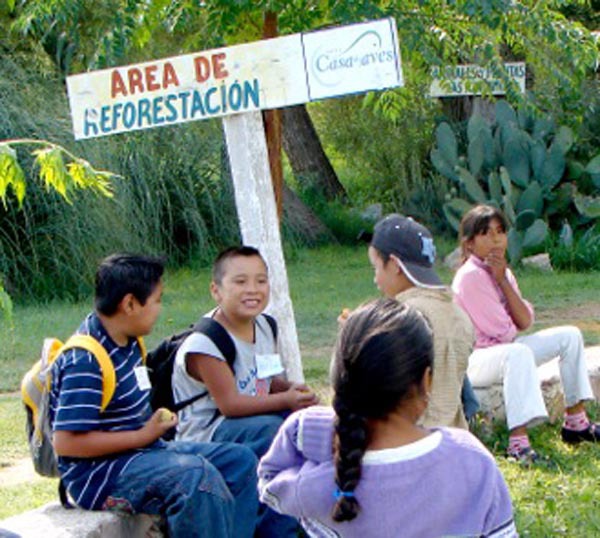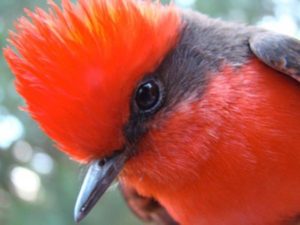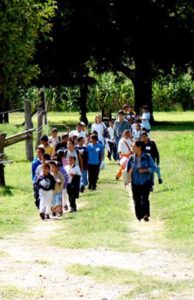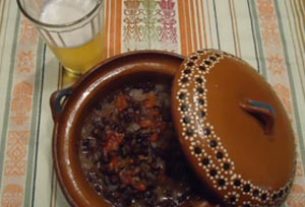I’m sitting in a third grade class at the Independencia School in San Miguel de Allende, Mexico. Aside from the charming teacher, there’s hardly a full set of teeth in the room, although nobody’s smile appears to be diminished by this defect. The teacher’s name is Fatima Almeida and she does not work for the school directly, but for PEASMA, the Proyecto de Educación Ambiental San Miguel Allende.
Seated next to me, also in a chair too small, is Linda Whynman, the president of Audubon de México. This organization is the only Audubon chapter in the country, and it celebrated its forty-fifth birthday earlier this year.
Fatima is busy fastening a four-foot diameter disc of kraft paper to the board, using magnets and double-stick tape.
“Any continents here?” she turns to ask the group of 35 kids, all in uniform. Four cardboard continents are raised on fingertips and there follows a small rush toward the blank western hemisphere. Puzzle-like pieces had been distributed earlier from a storage area under the concrete bleachers outside. They possess a look that is not only well-worn, but home-made. The New York and New Jersey coast seems to have taken a special beating, but perhaps it’s no different from the rest of these battered shores. Next come the oceans, a perfect fit. Some discussion follows on the difference between salt water and “sweet” water, agua dulce.
The Great Lakes are next, five pale blue pods, each somewhat blunted on the ends.
This is an environmental workshop that takes place two hours a week in each of six grade levels. It’s funded by a grant from the local Audubon to PEASMA. Linda leans over to me. “Thirty-five thousand kids have done this program in the last seven years.” She seems to feel a special resonance to the scene: she taught art for 30 years at all grade levels before running community arts programs for three counties in the state of New York.
It’s an enthusiastic group. Fatima is a tall young woman whose manner is warm and engaging. Scanning the classroom, I can see no one who isn’t participating. She hands out a stack of squares face down. Linda and I receive one too. On the board, Fatima has written category headings for domestic and wild animals. The kids come up, name the animal, and fix their square to the board under the correct heading. Mine is a tlacuache, a sinister-looking possum variety with patchy variegated fur, a face like a rat, and a tail as thick as your thumb. Everyone is shocked that I know what it is, but the truth is that I had used it in one of my mysteries. I had seen these creatures around San Miguel a couple of times at night, slinking away out of the headlights.
The Independencia School in San Miguel de Allende appears to be at capacity, with 426 students. The rooms have no heat and most of the kids are wearing uniform sweat suits. All the exteriors could use a paint job, but the interior where we’re sitting is presentable. No fixtures are turned on, but the ambient light is decent without being bright. Electricity is costly here, and having the lights on all day will force you into the highest rate bracket almost immediately.
Along one outside wall, in a space about two meters wide and four long, a man sits at his desk facing a computer. Two of the windows between him and the classroom are open. How he can focus on his work is not clear, but at least he has his own office on a campus where space is scarce. This is a workaround, common in México, a solution that looks temporary but may be permanent. The point is to defeat the limitations of space or budget and make things happen anyway.

This school program is one of a number of projects funded by Audubon in Mexico. They have followed the example of many in the U.S. but have also felt free to assist programs more specific to this country’s needs.
One is the Varanitas Stove project that reduces the fuel consumption — typically harvested timber — by 90%, and drops the indoor smoke and carbon gas emissions by a similar amount.
Audubon de México, through its Environmental Advocacy Committee, has also united with other organizations to promote the health of the aquifer, which is presently suffering a net loss in volume. This water system extends from the northwestern part of our state of Guanajuato, all the way down to Lake Chapala, south of Guadalajara. This project includes education and training in the countryside for laborers, students, landowners, and business people, partly with an eye to safeguard migratory bird habitat, as well as reinforcing the watershed as a resource for both human and animal life.
The Audubon chapter generally supports existing projects, rather than creating new ones. In addition to running small-group ecotours around Mexico, they are bringing down kayaks for sale to encourage appreciation of the beauty of our scarce water resources.
Besides the Varanitas stove project, their affiliate GAIA is also introducing dry toilets and composting to families and schools without plumbing.
Fatima Almeida moves to the wild animal side of the board and introduces the question of which of these species might be threatened. She points to the image of a songbird that I had never heard of. Was this bird one of those at risk?
A small girl in back raises her hand. Yes, she says solemnly, she believes it must be. Her family had one in a cage and the cat ate it.
This, of course, is the way ideas are introduced and nurtured. The coming generation is being influenced in this room where we sit. The connections are personal, the lessons particular. This curriculum also includes sessions on recycling, and programs for the hands-on separation of recyclable materials.
The Audubon group has consistently partnered with existing elements in the Mexican community, like PEASMA and FAI, (similar to Save The Children), using an approach framed in terms of cultural sensitivity.
Linda and I rose and gave our thanks, both to Fatima Almeida and the children. A guard at the gate unlocked it and let us out. The day was still gray, but the future looked somehow brighter because of Audubon de México.
See what else they are doing by visiting their website at: www.audubonmex.org
And yes, they do bird walks here too.





